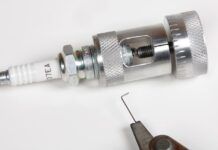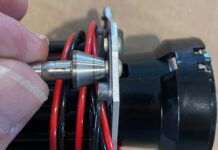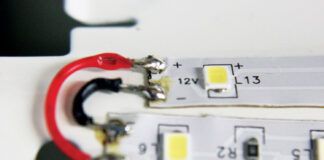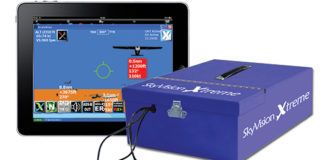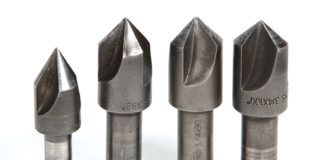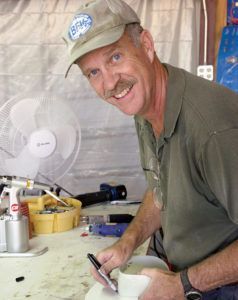 As a home machinist you’ll quickly get beyond just drilling a hole or reducing a diameter, and you’ll need to do some drawings. Pencil and paper have been relegated to the Sunday artists toolbox, so recently we took a look at SketchUp, a free bit of software to help you do some computer-aided design. Google, its maker, will tell you that SketchUp is not a “real” CAD tool because it is neither a solid-modeler nor a parametric-based program. It’s not a lot of other things as well, but we’ll get into that later.
As a home machinist you’ll quickly get beyond just drilling a hole or reducing a diameter, and you’ll need to do some drawings. Pencil and paper have been relegated to the Sunday artists toolbox, so recently we took a look at SketchUp, a free bit of software to help you do some computer-aided design. Google, its maker, will tell you that SketchUp is not a “real” CAD tool because it is neither a solid-modeler nor a parametric-based program. It’s not a lot of other things as well, but we’ll get into that later.
Now before you go throwing brickbats at me for succumbing to the lure of buzzwords and accuse me of baffling with BS, let me explain those two terms, and I think you’ll see that they are not only legitimate, but you’ll come to appreciate them.
First of all, understand that the model is what you build on the screen; the drawing is what you print out. With that definition locked down tighter than Bill Gates iPhone number, you’ll next need to understand that solid modeling means that the computer is able to assign material characteristics to what you draw.
For instance, if I draw a cube on paper, its a two-dimensional figure with the illusion of depth. If I draw it on the computer with SketchUp, its still a two-dimensional picture that the computer redraws so fast that it appears to be rotated, letting you look at the back side. But the object is still flat in the sense that the computer has done no volumetric calculations. If it’s a solid model, then not only can I rotate it, the computer knows the dimensions in three planes, and from that it can calculate the models mass and most any other physical parameter.
While you might not be particularly interested in doing finite element analysis to locate stress concentrations versus unneeded material, knowing the finished weight of a complex shape would be handy when considering adding it to your airplane.
That other term, parametric modeling, describes an even more useful feature. With paper and pencil, if you decide that a hole needs to be half an inch in diameter instead of a quarter inch, you have to erase the hole as well as the dimension, and then redraw both. Parametric modeling lets you simply click on the dimension, type in 0.5, click return, and the hole as well as the dimension will change. Then you just print out the updated drawing.
Another great advantage of CAD is that you can specify a hole size and location from which you can automatically create an entire array. If you want to get even fancier, dimension that first hole from its edge to the next feature, and the width of the material remaining will be maintained even if you change the hole size or spacing.
While SketchUp does not do this, Alibre Design Xpress does. Go to www.alibre.com for a free, genuine CAD program that does this and a lot more. It does not bury you in advertisements or demand you do anything other than learn it.
There is one wrinkle here, though its hardly a killer. The download is the company’s flagship program, which will expire in 30 days. But whats left is Design Xpress, a completely usable program that requires nothing further from you. The icons that go inactive are, for the most part, of little interest to us, but Ill have more to say on that in a bit.
Whats left? A lot! In addition to the ability to create solids and enjoy the advantages of parametric modeling, you get to bolt those solid models into an assembly. Not only can you place them on a single drawing, you can check to see if they really fit, motions can be simulated, and interferences are highlighted. Think about that for a
minute. Youll know if it all works without wasting the time and material of building the parts and assembling it, and you can try out several configurations easily. This one function is enough of a reason for anyone building an airplane to take the time to learn CAD.
The Help Files
Is there a downside? Given the complexity and potential of this program, I was not at all surprised that it took a lot longer to get up to speed with Design Xpress than with SketchUp. I have 13 years or so with CAD, and I was able to make a drawing within an hour of loading the program. But a beginner might take several evenings of noodling around to get up to drawing a flat panel and punching a few holes. The good news, though, is thats all you’ll need to create a panel drawing from which you can work.
The learning curve is aided by a fairly comprehensive set of tutorials that I enjoyed and found quite helpful in getting beyond the its-installed-now-what phase. But I also saw potential for improvement. One flaw is in the Help files. Suffer from Yoda syndrome they do. Give you an example I will when clicking help you do: “In an assembly workspace, select Check for Interferences from the Tools menu to access the Interferences dialog box.”
How this sort of convoluted syntax gets included in help files is a mystery; my own spell-checker kept giving me a dope-slap as I concocted that lead sentence, never mind the difficulty of just thinking it up. Maybe the author wrote those IQ tests in which they deliberately give you a complex paragraph and then ask you several questions to see if you know what the author meant.
Another zinger was “Select the Options arrow under the Parallel Constraint tool on the Sketching toolbar.” To follow what they want me to do, I have to read this sentence backwards, that is, I should go to the Sketching toolbar (got it), find the Parallel Constraint tool (there it is) and then select the Options arrow (ah, there we go).
What it should have been is: To select the Options arrow, go to the Sketching toolbar, then the Parallel Constraint tool, then the Options arrow. Or better still:
- Goal – Options Arrow
- Path – Sketching Toolbar > Parallel Constraint Tool > Options Arrow
The largest annoyance, though, is that classic from the days of paper dictionaries. Say the reader needs to use the Constraints function. He’s told, “Click on the Constraints icon and…” I know what I want to do, I just don’t know what the icon looks like or where it is. And the guys that write manuals wonder why no one reads them?
Maybe Im used to it, though, because in spite of this panegyric to George Lucas and IQ exams, I was able to get through the lessons without too much other pain. And, as noted, the tutorials are really quite good.
At the opposite end is a great set of six CDs that will lead you through the entire learning curve. These are for a price, and they’re necessary if you really want to advance beyond whats needed for panel design.
What You Don’t Get
You’ll get used to the “Shell” feature in a hurry. Shell is a wonderful feature of CAD programs that allows the designer to remove internal material from a solid model to create walls; converting a solid cylinder into a can is perhaps the simplest example.
After 30 days, this icon will become grayed out. I wasn’t particularly pleased with this and thought it unwise in that Shell is not an adjunct feature such as, say, Stress Analysis.
My initial take was that marketing had made a mistake here and simply irritated the user in a fashion akin to selling 35-inch yard sticks: “The customer can still measure 3 feet with a couple of extra steps, but we prefer to offer the 36-inch version as an upgrade.” However, for $249 you can get it back along with a lot of other nice tools that might entice you up the ladder to the flagship program. And if they’re not running a half-off promotion, wait a bit and it’ll be back.
“Free” has a limitation. The Save/Export functions are disabled for assemblies of more than five different components. It’s still usable, especially when that number is for different components. Eight switches on an instrument panel count as one part against the limit, so this is not an always-fatal restriction for the home machinist. If you want more than that, register the program and the number is increased to 10.
As for that registration, the company says it will not divulge your address to anyone other than close associates, so being buried in spam shouldn’t be a problem. Would I personally use it? Absolutely. It’s the most for the money Ive seen in many years of working with CAD. So to get going, visit www.alibre.com and noodle around until you find the free download. At 116MB it’s a large one, so act accordingly.
Laser Cutting Your Panel
Now that you’ve gotten your drawings done, what do you do with them other than go out to the shop and start making chips? How about you put the precision of CAD and the accuracy of your design to work in a fashion that uses those advantages? Cut your panel with a laser!
You don’t have a laser cutter in the shop? Neither do I, so I went to my friends at Pega Precision in Santa Clara, California, with the drawing. “Sure, we can do a one-off,” said Aaron Fast, VP of this cutting-edge (pun intended) shop in the heart of the Silicon Valley.
Note here that precision and accuracy are not synonymous: A clock could read in tenths of a second (precision) but be off by 20 minutes (accuracy), so it would seem incumbent upon you, the designer, to make sure you have the hole sizes and spacing correct.
But that holds true if you’re laying it out with a pencil as well, so while still being as accurate as you can, don’t obsess over the minutia. Remember, this is intended to speed up the process while making precise holes in a perfectly straight line. You can always add a hole or enlarge a notch once the major layout is completed.
Back at Pega Precision, Fast went on to explain that although he can take a paper drawing and convert into a DXF type of file, it will add to the cost. So, having drawn my panel on the computer, all I needed to do was export it in the DXF format and email it to him. He promised to ship a finished panel back to me within a few days, but I wanted to see the process, so I went to the shop, camera and notebook in hand.
After you’ve drawn it, this is a four-step process. First, Fast will give it a good look-over and let you know if anything is grossly amiss. Next, Phong Phan in programming will translate your drawing into something the computers will read. Among other things hell check for circles that should not be closed such as “9”. It these were cut as printed, the top of the digit would become a hole.
Phan then copies the finished file onto a disk and sends it to the cutting department, where Duc Ho does the laser work. After the hours you’ve spent in the design phase, its almost disappointing that cutting is so quick. My panel took only 4:49 from first to last…thats minutes:seconds!
At this point, the neatly cut panel could be shipped to you, but you also have options. I had my panel grained and Fast sent it out to black-anodize. It could have been random-sanded to a flat finish and/or anodized in any color of the rainbow. A word of caution: Anodize comes in two flavors, hard and soft. Hard comes out a dirty brown, so a black dye is added. Soft is clear, so any color you like can be added. However, soft anodize will scratch easily and fade in direct sunlight.
Had I wanted Pem-type fasteners, they could have been added. Just mark the location, specify the size and there you go…not quite. Anodize destroys steel, so fasteners have to be added afterwards, which means theyll show. You can plan ahead on this issue by making sure that you have washers that cover the steel.
I chose to not take this route because the spacing is critical, and it can be a bit difficult to measure this on the instrument itself. If the instrument manufacturer supplies a diagram, great, but it’s easy to position the instrument and then drill through the existing holes. Also of note is that hard anodizing is non-electrically conductive, so if you’re going to ground the panel, let Pega Precision know and they’ll mask an appropriate area.
All this is fancy, of course, but the real advantage comes about by using more than just the speed and accuracy. A panel punch will make a nice round hole, and so will a hole saw. What they wont do is leave behind a tab to keep the switch from rotating. Fast says that his laser can cut a virtually zero radius corner, so just specify what youd love to have and you’ll get it.
That brings us to the real icing on this cake. I simply typed in my N number on the drawing and got it cut into the panel. Ill back it up with an electro-luminescent strip (Hey, Stein, how about explaining these?) and have a beautiful final touch. It was not until I saw the perfection of the cutting that it occurred to me I could have done all of the labels this way. Next panel!
By now you’re thinking that this is a super expensive process. Heres the good news: The drafting software is free, and itll only take a few evenings to get proficient. You don’t need to draw each instrument unless you’re obsessive and/or really want to pack them tight and check clearances; just draw circles and squares and “cut” out the holes.
Then email the file to Pega Precision (visit www.pegaprecision.com for more information). Fast says that a panel like mine, cut from 0.090-inch aluminum, will cost about $175 plus shipping. Add a few dollars for anodize, go work on something else, and watch for the UPS truck in a couple of days.
I did a quick check for fit with the various instruments, and it was spot-on. I should have allowed a bit more clearance (0.020 inch on each side is adequate) and remembered to include the tab for the ignition switch (I did put tabs on all the toggles). I’ll be installing this one in a Jabiru J250, so keep an eye out for it in a future series. If you download Alibre and/or go this route, let me know. Id like to hear of your success.








